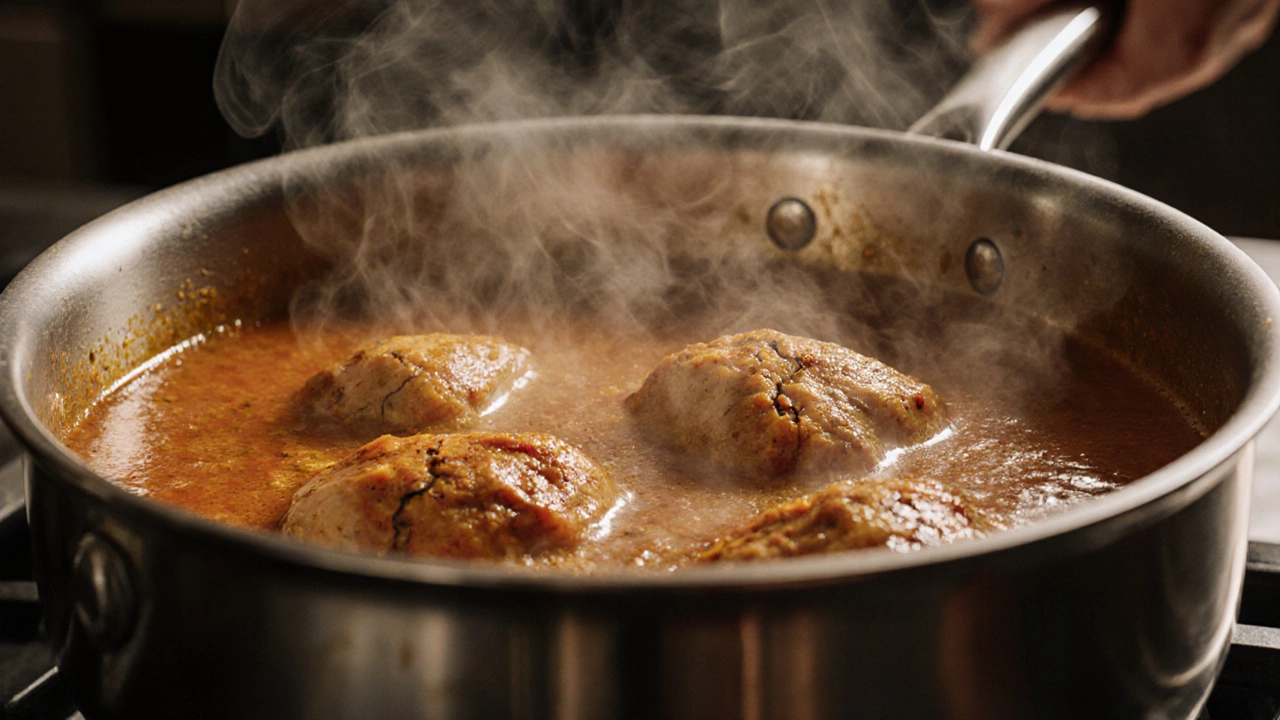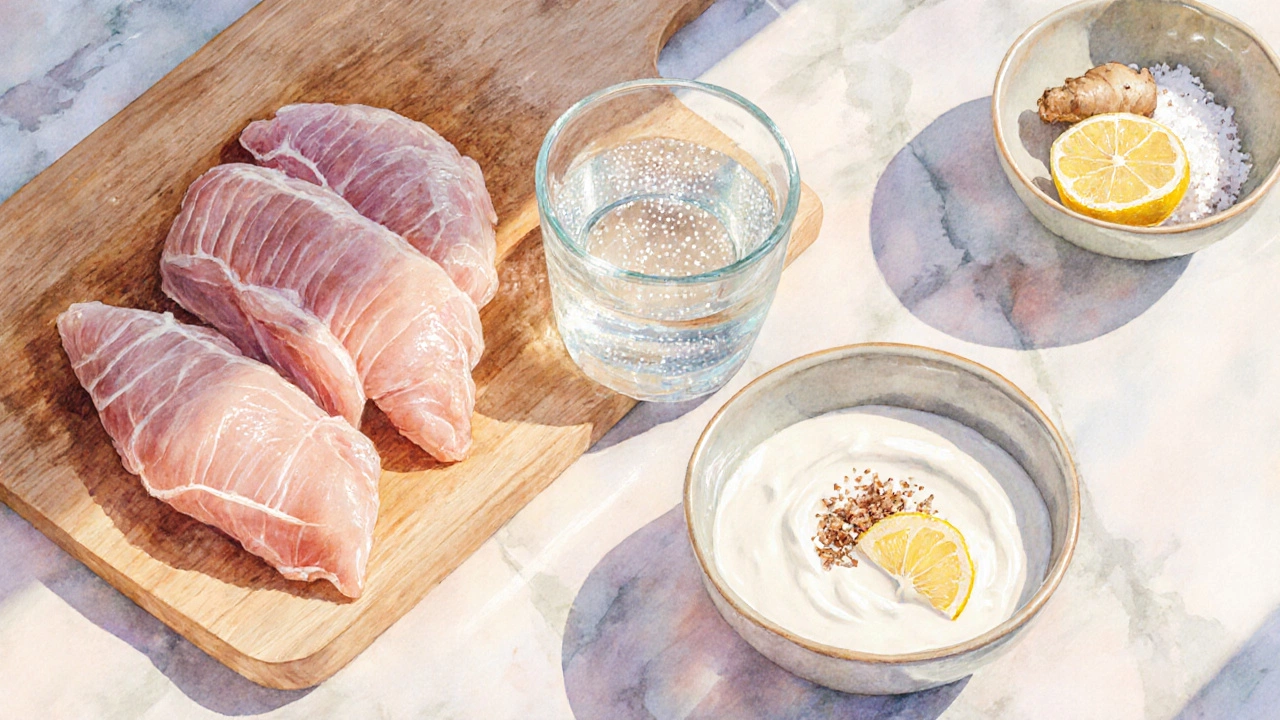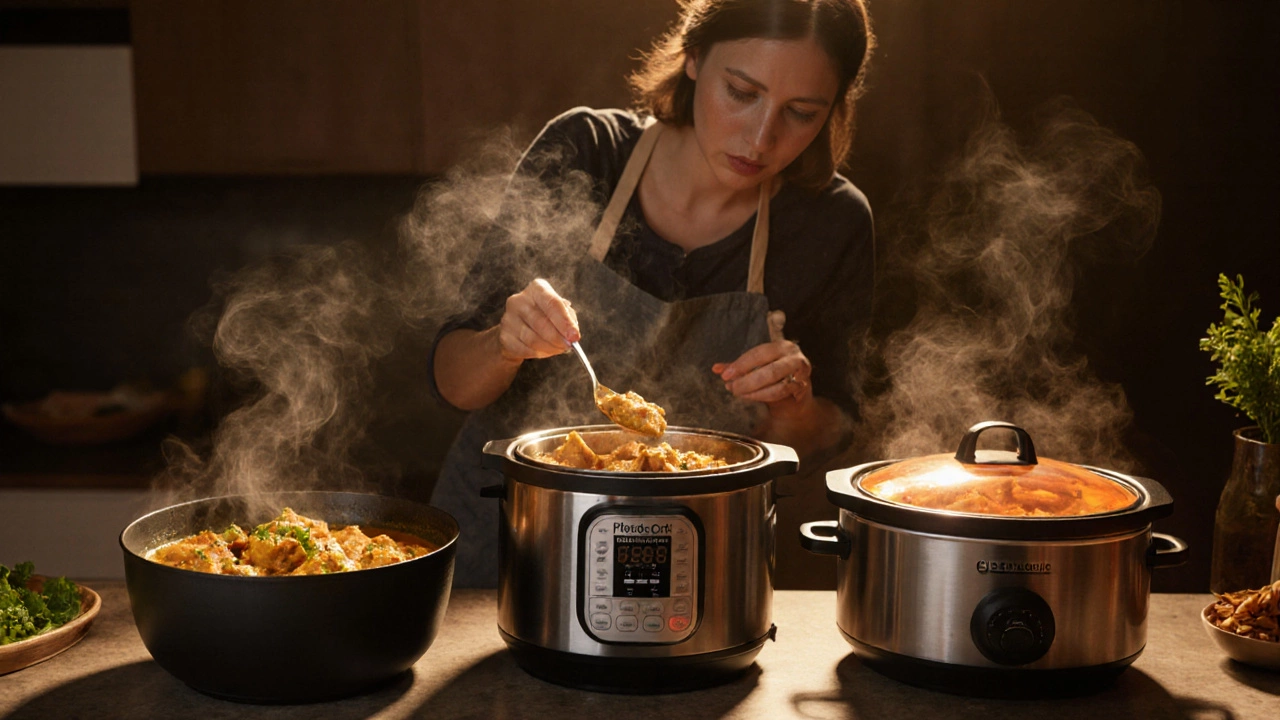Why Your Chicken Curry Turns Tough and How to Fix It
 Oct, 15 2025
Oct, 15 2025
Chicken Curry Tenderizer Calculator
Find Your Perfect Chicken Curry Cooking Time
Enter your details to get customized cooking recommendations for tender, juicy chicken curry.
Optimal Cooking Guide
Science-Based Recommendation
The recommended time ensures collagen converts to gelatin without overcooking, keeping the meat juicy.
Key Takeaways
- Overcooking, high heat and lack of moisture are the top reasons chicken gets tough in curry.
- Cutting the meat against the grain and using brine or an acidic marination keep it juicy.
- Low‑and‑slow simmer, pressure cooking or slow‑cooking each have pros and cons; choose the method that fits your schedule.
- Adding a dairy element like yogurt or coconut milk protects protein fibers from drying out.
- Follow the troubleshooting checklist before you serve to rescue a dry batch.
When you bite into a serving of tough chicken in a fragrant curry, it feels like you’ve taken a step back in cooking skill. The good news? The problem is almost always mechanical, not mystical. By understanding the science behind chicken texture and tweaking a few steps, you can turn a rubbery disaster into melt‑in‑your‑mouth comfort food.
What Makes Chicken Tough?
First, let’s meet the main players. Chicken is a lean protein that contains bundles of muscle fibers, connective tissue (mainly collagen), and water. When you drop it into a curry, three forces decide its final texture: heat, moisture and acid (if you use one).
When heat is too high or the cooking time stretches beyond the point where collagen has turned into gelatin, the muscle fibers contract aggressively, squeezing out water. The result is a dry, rubbery bite. Conversely, gentle heat and a bit of moisture keep those fibers relaxed, allowing the collagen to melt and the meat to stay juicy.
The Science Behind the Bite
Chicken is about 70% water. That water is bound to proteins like myosin and actin. As temperature climbs past 65°C (149°F), these proteins denature and tighten, expelling water. Collagen, the connective tissue, begins to dissolve into gelatin around 70‑80°C (158‑176°F). If you stop cooking before the gelatin conversion is complete, the meat stays tough. If you overshoot, the meat dries out because the gelatin has already released its water.
Acidic ingredients (lemon juice, vinegar, tamarind) help by slightly breaking down protein bonds before heat even arrives. This pre‑tenderizing effect is why many Indian marinades include yogurt or citrus.

Common Culprits in a Tough Chicken Curry
- Cooking at a boil. A rolling boil sears the outside, locking the juices out.
- Skipping the cut. Cutting chicken across the grain (perpendicular to the muscle fibers) shortens those fibers, making chew less noticeable.
- Not enough liquid. Curry sauces that evaporate too quickly leave the meat dry.
- Over‑salting early. Salt pulls moisture to the surface, which then evaporates.
- Missing the acid. Without an acidic component, the protein stays stiff.
Practical Ways to Keep Chicken Tender
- Trim and slice wisely. Remove excess skin and cut pieces 2‑3cm thick, slicing against the grain.
- Brine for 15‑30minutes. Dissolve 1Tbsp salt in 1cup water, soak the chicken, then pat dry. The salt relaxes muscle fibers.
- Marinate with acid and dairy. Mix ½cup plain yogurt, 1Tbsp lemon juice, minced ginger and garlic. Let sit 30minutes (or overnight for deeper effect).
- Start low, finish high. Begin the curry on medium‑low heat, allowing the sauce to thicken slowly. Finish with a brief high‑heat burst if you need a richer color.
- Cover the pot. Trapping steam adds moisture, preventing the sauce from drying out.
- Rest before serving. Let the curry sit off the heat for 5minutes; the juices redistribute.
Choosing the Right Cooking Method
Different kitchens favor different tools. Below is a quick comparison of the three most common ways to simmer chicken curry.
| Method | Typical Time | Heat Level | Moisture Retention | Best For |
|---|---|---|---|---|
| Stovetop Simmer | 25‑35min | Low‑medium, covered | High | Traditional flavor development |
| Pressure Cooker | 8‑12min (high pressure) | High (but sealed) | Very high (steam‑locked) | Busy weeknights |
| Slow Cooker | 4‑6h (low) / 2‑3h (high) | Very low | Very high | Set‑and‑forget meals |
All three can produce tender chicken if you respect the temperature‑time curve. The stovetop route gives the richest caramelized notes; the pressure cooker saves time but requires careful timing to avoid over‑cooking; the slow cooker is forgiving but needs enough liquid to prevent drying.

Step‑by‑Step Recipe Tweaks
- Heat 2Tbsp cooking oil in a heavy‑bottomed pan over medium‑low.
- Add diced onions, sauté until golden (about 8min). This builds a flavor base and releases moisture.
- Stir in ginger‑garlic paste, then the pre‑marinated chicken. Cook just until the surface changes color - do not brown aggressively.
- Pour in canned tomatoes, a splash of water or broth, and the remaining yogurt. Bring to a gentle simmer; you should see tiny bubbles, not a vigorous boil.
- Reduce heat, cover, and let cook for 20‑25minutes, checking midway that the sauce isn’t drying out. Add a ladle of warm water if needed.
- Finish with a squeeze of lemon, a handful of fresh cilantro, and a pinch of garam masala for aroma.
- Turn off the flame and let the curry rest, covered, for 5minutes before serving.
This routine balances low heat, adequate moisture, and a modest acid boost - the winning trio for tender chicken.
Quick Troubleshooting Checklist
- Did the sauce boil? Lower the heat and cover.
- Is the chicken bite still firm after the recommended time? Add ½cup water, re‑cover, and simmer 5‑10min longer.
- Too salty? Stir in a small amount of unsalted yogurt or coconut milk.
- Flavor flat? Finish with extra lemon juice or a dash of garam masala.
- No sauce left? Add broth or canned tomatoes and let the curry return to a low simmer.
Frequently Asked Questions
Why does chicken become rubbery even if I cook it gently?
Even low heat can over‑tighten proteins if the cooking time exceeds the point where collagen turns to gelatin. The muscle fibers keep contracting, squeezing out moisture and leaving a rubbery texture.
Can I use boneless thighs instead of breast for a softer result?
Yes. Thigh meat contains more intramuscular fat and connective tissue, which melt into gelatin, naturally keeping the meat moist. Just adjust cooking time a few minutes shorter to avoid dryness.
Is brining necessary if I’m marinating in yogurt?
Not strictly, but a short brine can further relax the fibers, especially for lean breast pieces. If you’re short on time, a 30‑minute yogurt marination works well on its own.
What’s the ideal final internal temperature for chicken in curry?
Aim for 74°C (165°F). At this point the meat is safe, and the collagen has had enough time to convert without drying out.
Can I rescue a curry where the chicken is already dry?
Yes. Shred the chicken, then simmer it in extra broth or coconut milk for 10minutes. The meat will re‑absorb moisture and blend back into the sauce.
